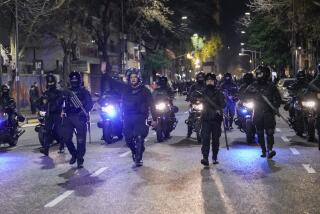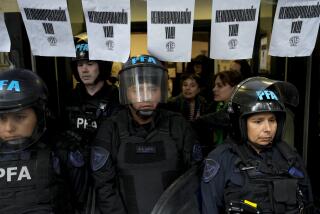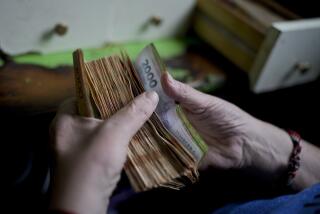Argentina Moves to Drop Peso’s Peg to the Dollar
- Share via
BUENOS AIRES — Argentina’s interim government gave the first sign Wednesday that it was preparing to abandon a decade-old policy of keeping the peso valued at one U.S. dollar, and shopkeepers started raising prices to hedge against an almost certain devaluation.
Three days after Adolfo Rodriguez Saa was installed as president for three months after looting and riots forced out President Fernando de la Rua, the new finance chief said he was preparing an “orderly exit” from the practice of pegging the peso at one U.S. dollar.
Finance Secretary Rodolfo Frigeri said he was printing a third currency, to be used to pay state salaries, that would be allowed to depreciate against the dollar, perhaps eventually replacing the peso.
But as concerns grew that the government could be overtaken by events, store owners fearing devaluation raised prices or canceled the huge discounts with which they had tried to drum up business in a recession that has dragged on for four years.
Banks and foreign exchange houses were shut for most business for the fifth straight day and ATMs ran dry after a month of drastic curbs on cash withdrawals.
The Central Bank lifted the banking holiday for today, but foreign exchange trading was to remain suspended. It also cut its minimum reserve requirement by 6 percentage points to help inject liquidity into the banking system.
It was unclear whether the stock exchange, which suspended business amid the extended bank holiday, would resume trading today.
Rodriguez, who suspended payments on the nation’s crippling $132-billion debt after taking office Sunday, wants to print cash and divert debt payments to pay for job and social welfare programs.
One in five people in the work force is unemployed in Argentina, a South American nation of 36 million people. The average wage is $600 a month, but many prices are at European levels.
Despite a drop in Christmas shopping, with many people having no access to cash and savings stashed away in dollars, retailers’ association CAME said many shops had “hiked prices in pesos up to 20% in the last 72 hours given the uncertainty surrounding the exchange rate parity.”
Frigeri said the interim government would neither devalue the peso nor touch the bank deposits of jittery savers, adding that a law governing the new third currency should be ready by the weekend.
The dollar peg brought Argentina inflation-free financial stability after being introduced in 1991 but it also made it one of the most expensive economies in the world for doing business. The peg is blamed by many for the stubborn recession.
The president, a member of the opposition Peronist Party, faces huge pressure to end growing unemployment and steep wage cuts that sparked the end of De la Rua, who quit after his economic austerity plans triggered looting and rioting that left 27 people dead.
Rodriguez addressed the General Workers Federation (CGT), the largest umbrella union group and a traditional Peronist stronghold, to rapturous applause on Wednesday.
“When we have to suffer, all of us will suffer equally,” he told union leaders.
Calm has returned to the capital, where police battled with rioters outside the presidential palace and middle-class protesters took to the streets banging pots and pans.
Rodriguez is in power until March, when Argentines will vote for a president to complete De la Rua’s mandate ending in 2003.
The new currency, the Argentino, will be used to pay state salaries. But unlike the peso, it will not be backed by hard-currency reserves, leaving it vulnerable to devaluation.
More to Read
Sign up for Essential California
The most important California stories and recommendations in your inbox every morning.
You may occasionally receive promotional content from the Los Angeles Times.










